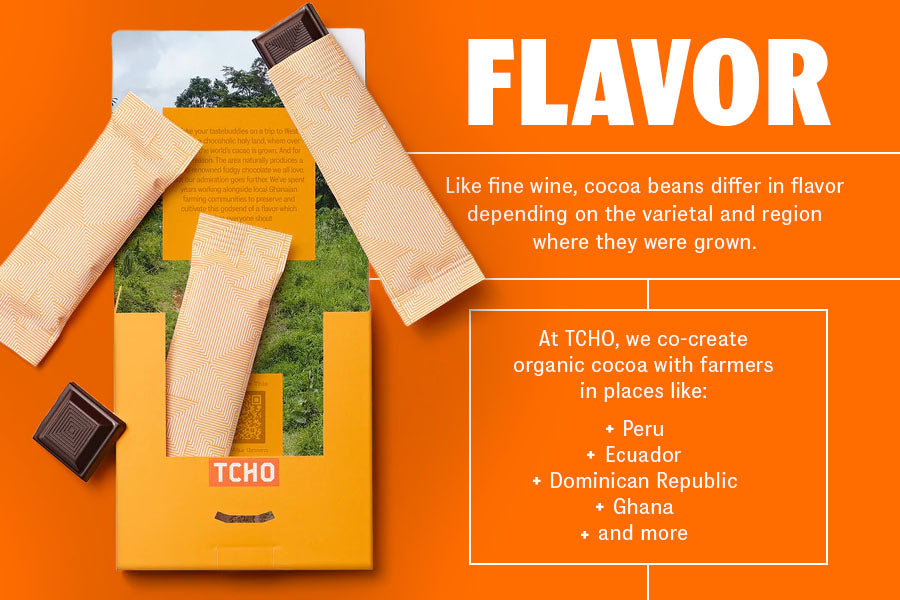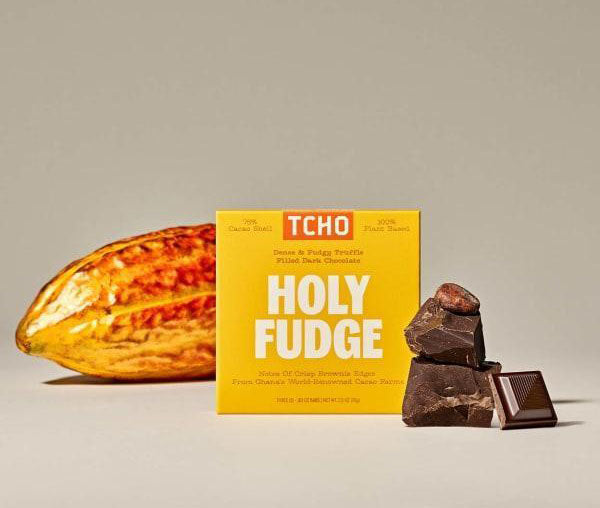
There’s no denying it: Chocolate is one of the world’s most beloved foods. In fact, nearly 5 million metric tons of cocoa are produced per year, proving that there’s no such thing as too much of this stuff. But you don’t need stats to know that chocolate reigns supreme. Chances are, you’ve got some in your pantry right now! To stave off the cravings, we’d recommend grabbing some before reading about how it’s made.
If you’re like most Americans, you probably consume about 11 pounds of chocolate each year. We did the math, and that’s about 70 TCHO bars annually! But have you ever stopped to think about how, exactly, the chocolate is made? In this guide, we’ll cover everything you need to know about how we take organic cocoa beans and turn them into craft chocolate bars.
What Is Chocolate Made Of?
Before we dive into the production process, let’s take a peek into what, quite literally, goes into each batch of chocolate. Chocolate is primarily made up of three key ingredients — cocoa beans, sugar and fat — but many chocolatiers add other ingredients to enhance the chocolate’s flavor or texture.
Cocoa Beans
Derived from the tropical Theobroma cacao tree, cocoa beans, aka cacao beans, are by far the most important ingredient in chocolate-making, which is why the TCHO team has worked with farming partners worldwide for over a decade to perfect the flavor of ours. The Nerf-football-shaped fruit of the cacao tree, called the cacao pod, houses the seeds from which chocolate is made.

A ripe cocoa bean has an incredible purple flesh color.
Indeed, the key to delicious gourmet chocolate is a well-cultivated cocoa bean. Growing cocoa beans is a painstaking process similar to that of growing grapes for wine. Everything from the soil to the temperature to the specific variety of the bean makes a difference when it comes to flavor. Not only are the cocoa nibs from cocoa beans melted down to produce chocolate, but the fat from the cocoa pod (called cocoa butter) is also used for flavor and texture.
Cocoa beans are primarily produced in West Africa, Indonesia, Brazil and Ecuador. At TCHO, we source much of our cocoa beans supply from small farms in Ghana, Peru, Ecuador and Madagascar. Our chocolate is Fair Trade certified, which means we work hard to ensure that our beans are sourced ethically in ways that provide sustainable livelihoods for the farmers and workers who supply us with our beans.
Chocolatiers don’t simply toss the whole pod into their recipes. Processing cocoa beans involves fermenting, roasting and refining, all before it can be melted down to create gourmet chocolate. More on that part below!
Discover Our Ethically Sourced Chocolates
Sugar
Even the best cocoa beans are naturally bitter and astringent to a certain degree, so chocolatiers rely on sugar to create the sweetness we associate with the treat. Even dark chocolate, which typically contains the least amount of sugar out of all varieties, is made with some sugar to help bring out and balance the natural cocoa flavors. At TCHO, we use organic cane and coconut sugar to ensure the highest possible quality of chocolate.
Cocoa Butter
Cocoa seeds or “beans” are made up of about half fat (cocoa butter) and half cocoa solids (the brown stuff or cocoa powder). The ground, roasted cocoa beans are what we use to produce chocolate, including the cocoa butter component. Occasionally we add a small amount of extra organic cocoa butter in our chocolate to help give it a rich, creamy texture and enhance the flavor. You may also see coconut oil or other forms of fat (such as nut butter) in your chocolate to help highlight the flavor and texture of the product.

Added Ingredients
What’s better than pure chocolate? Pure chocolate mixed with other delicious extras like nuts, coffee beans, vanilla beans, toffee, sea salt and so much more. Craft chocolatiers often enhance their creations with tasty add-ins to add chew, crunch or bursts of flavor in every bite.
Only the Good Stuff Here
By the way, TCHO chocolate is 100 percent plant-based, Certified Organic, Fair-Trade Certified, soy-free and non-GMO, so you can feel good about every indulgent square. Oh, and every cacao bean is fully traceable to its source for complete transparency.
How Chocolate Is Made
Like all of the best things in life, chocolate-making is truly a labor of love. In fact, each batch of chocolate takes about 24 to 30 hours to produce. Oh, and that’s after the six months it took the cocoa seeds to mature on the farm plus the months required to ferment, refine and ship the cocoa liquor to our factory! So, yeah, the bag of chocolate you mix into your chocolate chip cookies probably took at least a year to go from bean to bag. Pretty sweet. Literally.
Grow the Beans
Our whole chocolate-making process begins with co-creating the great beans with our farmer partners through specific varieties of cocoa grown, fermentation and drying processes and carefully managed roasting.

Like fine wine, cocoa beans differ widely in flavor depending on the varietal and the region where they were grown, and there is plenty of nuance in their tasting and selection. At TCHO, we co-create organic cocoa with farmers in places like Peru, Ecuador, the Dominican Republic, Ghana and more to produce top-quality cocoa beans to ensure that we make the best possible chocolate from scratch.
Ferment and Roast the Beans
Once harvested, cocoa beans are fermented for up to a week to develop complex flavor, mellow out bitterness and create a rich, brown color. Next, the beans are typically sundried for up to two weeks before getting put into burlap sacks for shipment to a warehouse.
There, they are cracked to separate the shells from the cocoa nibs. The nibs are the purest form of chocolate and what eventually becomes the primary ingredient we use to make the good stuff. The nibs are carefully roasted and ground into an unsweetened cocoa liquid, similar to how an unsweetened nut butter is made. The nibs are then placed in a refining machine, melted down and sent to chocolate factories in blocks.
Refine and Melt the Cocoa
After finding the best cocoa beans and roasting and grinding them to their optimal flavor profile, we are ready for the next step in the chocolate-making process. This roasted, ground cocoa, known as cocoa liquor, is shipped on a container ship to our factory here in Berkeley, California.
Once here, the melted cocoa liquor then goes through a lengthy process of further refining, where we gently grind the sugar and cocoa together to create an impeccably smooth, creamy texture. We want our cocoa to be ultra-fine — we’re talking about 15 to 20 micrometers per particle — to give it a premium flavor and texture.

Conch the Chocolate
The next step in the chocolate-making process is conching, a technique so named because it was originally done in a vessel that resembled a conch shell. During the conching process, the freshly refined chocolate is mixed together at different temperatures for varying lengths of time to achieve the final target flavor and texture. This process helps evenly distribute the cocoa butter and other fats throughout the chocolate and helps smooth it out even more.
Taste the Chocolate
Like any good food, you’ve got to taste your chocolate along the way! And this is the right time to do it. The refining and conching processes are extremely important for high-end chocolatiers. The fineness, texture and flavor of your chocolate are what differentiates standard chocolate from great artisan or craft chocolate. That’s why we do a ton of tasting (aka sensory quality analysis) at this phase to ensure consistency and quality of every single batch that is made.
Temper the Chocolate
Tempering is the process of gently heating and cooling the liquid chocolate at different intervals to help give it a more stable crystal structure when it is finally cooled into a solid chocolate bar. As the temperature of the liquid chocolate is adjusted, a complex chemical process occurs. To put it simply, during tempering, the crystals in the cocoa butter shrink down to a small, uniform size. This brings out lots of beneficial qualities that make the chocolate delicious and beautiful.

To be specific, we temper chocolate so that after it has cooled and solidified in molds, it has a brilliant sheen and amazing flavor. Tempering also prevents chocolate from separating from the packaging and inhibits it from melting easily. It also gives chocolate that super-satisfying snap you love to feel when breaking apart squares to share or save for later. Basically, tempering is the finishing touch that makes chocolate chocolate.
Mold the Chocolate
This is the step where the chocolate takes its final form. Whether bars, chips, crumbles or discs, chocolate must be formed into its final shape using the help of molds. Our machines pour the refined, tempered chocolate into molds before it is packaged and sold.
All of these steps will help ensure that the chocolate you pick up at the grocery store is tasty and stays fresh until you get the chance to enjoy it. How long does chocolate last, you ask? When properly stored, your chocolate can last up to a year from the time it is crafted. But who really wants to wait that long to eat it?
Bean-to-Bar Chocolate
When shopping for gourmet chocolate, you may come across the phrase “bean-to-bar.” This model is used by chocolatiers who buy cocoa beans from farms and then do the refining and roasting themselves. Although there is no official definition of “bean-to-bar,” it essentially indicates that much of the cocoa bean processing occurs on-site in factories rather than at the farm or facility where the beans are grown.
So, with this in mind, is TCHO chocolate considered “bean-to-bar”? No, we do not meet the definition of bean-to-bar, and it’s because we choose to roast at origin. This allows us to keep more money in the communities where we grow our cacao, while also significantly decreasing our greenhouse gas emissions due to the fact we import chocolate liquor as opposed to very large bags of beans.

From Seed to Treat
For something as ubiquitous as chocolate, it’s surprisingly easy to underestimate the complexity that goes into each bar. In reality, the production process can take many months or even years, especially if you choose high-end chocolate. The next time you bite into a decadent square of TCHO chocolate, remember that it was made with the utmost care and love from the very first day on the farm!
Image Credits
Africa Studio/Shutterstock.com
Shulevskyy Volodymyr/Shutterstock.com
showcake/Shutterstock.com
fjmolina/Shutterstock.com